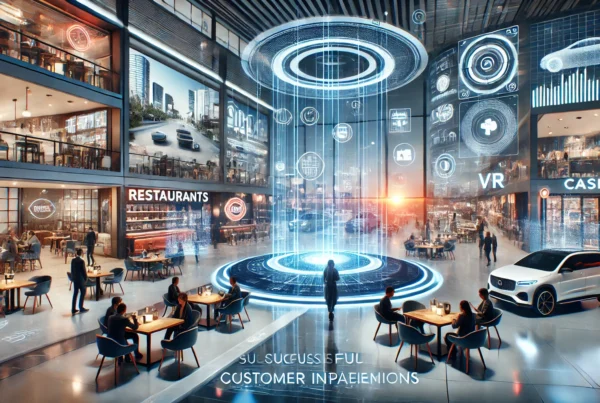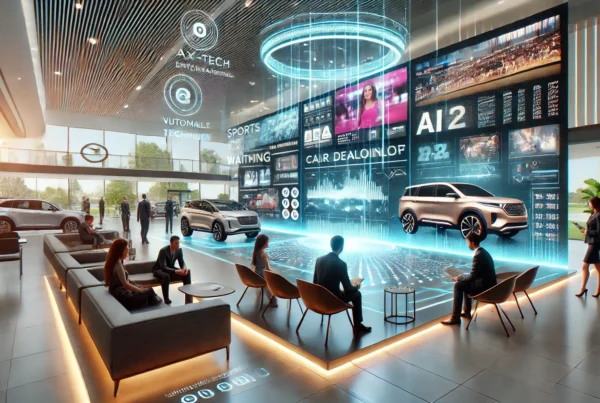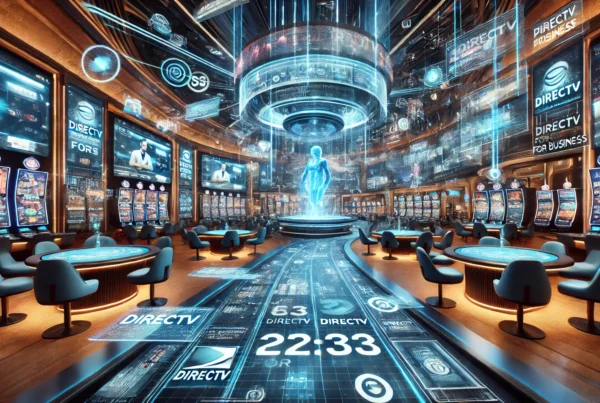Imagine walking into a buzzing restaurant or a thriving casino where every corner invites you to interact, engage, and be entertained. This isn’t just a vision of the future—it’s the reality of maximizing engagement with interactive entertainment. As we step into 2025, businesses across hospitality, gaming, and other industries are embracing this dynamic approach to captivate their audiences like never before.
In a world where customer attention is a prized commodity, interactive entertainment stands out as a game-changer. For business owners and decision-makers in industries such as hospitality, gaming, and automotive, the ability to transform passive customers into active participants is invaluable. This shift not only enhances the customer experience but also builds brand loyalty and drives revenue growth.
At Sports Direct, we understand the power of interactive entertainment in creating memorable experiences. Whether it’s through innovative video programming solutions or creative engagement strategies, our mission is to help businesses like yours unlock the full potential of on-premise entertainment. This blog post will explore the latest trends, provide actionable insights, and offer practical tips to help you harness the power of interactive entertainment.
Stay with us as we delve into the transformative impact of interactive entertainment, starting with the essential strategies you can implement today. Discover how these approaches can elevate your business and keep your audience coming back for more.
Understanding Interactive Entertainment and Its Impact
In an era where passive consumption no longer captivates audiences, interactive entertainment emerges as a transformative force. By turning spectators into participants, it significantly enhances engagement across various sectors. This section delves into the essence of interactive entertainment and its profound impact on industries such as hospitality, gaming, and automotive.
Interactive entertainment is not just a trend; it’s a revolution in how we engage with content. By incorporating elements like quizzes, polls, and augmented reality, businesses can create immersive experiences that captivate their audiences. This shift from passive to active engagement is crucial in today’s competitive landscape, where capturing attention is more challenging than ever.
Interactive Elements: Quizzes and Polls
Quizzes and polls are among the most effective interactive tools for engaging audiences. They invite users to participate actively, providing immediate feedback and personalized results. For instance, a restaurant might use a quiz to suggest menu items based on customer preferences, enhancing the dining experience. According to a study by Mediafly, interactive content like quizzes can boost engagement by up to 52.6% compared to static content.
Polls, on the other hand, are excellent for gathering real-time feedback. They allow businesses to understand customer preferences and make informed decisions. A casino could use polls to determine which games are most popular among patrons, tailoring their offerings accordingly. This not only increases customer satisfaction but also fosters a sense of community and involvement.
Augmented Reality: A New Dimension
Augmented reality (AR) is reshaping how industries engage with their audiences. By overlaying digital information onto the real world, AR creates immersive experiences that captivate users. In the automotive sector, AR allows potential buyers to visualize how a car would look in different colors or with various accessories, enhancing the purchasing experience.
In the hospitality industry, AR can transform a simple meal into an interactive journey. Restaurants can use AR to provide information about the origins of ingredients or suggest wine pairings, enriching the dining experience. This technology not only entertains but also educates, making it a powerful tool for maximizing engagement.
Case Studies: Success Stories Across Industries
Several industries have successfully harnessed the power of interactive entertainment to boost engagement. For example, BuzzFeed’s personality quizzes have become iconic, engaging millions and encouraging social sharing. Similarly, Netflix’s ‘Bandersnatch’ offers viewers a choose-your-own-adventure experience, significantly increasing viewing time and engagement.
In the automotive industry, brands like Audi have used AR to allow customers to explore car features in detail, leading to higher conversion rates. These case studies demonstrate the versatility and effectiveness of interactive entertainment in capturing and retaining audience attention.
By embracing interactive entertainment, businesses can create memorable experiences that resonate with their audiences. Whether it’s through quizzes, AR, or other interactive elements, the potential to engage and inspire is limitless. For more insights on how to implement these strategies, explore our comprehensive resources at Sports Direct.
Strategies for Implementing Interactive Entertainment
Incorporating interactive entertainment into your business strategy can be a game-changer, but it requires careful planning and execution. By adopting the right strategies, businesses can effectively maximize engagement with interactive entertainment, creating memorable experiences that captivate audiences. Below, we outline actionable steps to seamlessly integrate interactive elements into your customer engagement efforts.
Interactive entertainment is not just a trend; it’s an essential component of modern business strategies. By strategically implementing interactive elements, businesses can transform passive consumers into active participants, fostering deeper connections and enhancing brand loyalty. This section provides a step-by-step guide to help you effectively incorporate interactive entertainment into your business model.
Step 1: Define Your Objectives
Before diving into the world of interactive entertainment, it’s crucial to clearly define your objectives. Are you aiming to increase customer engagement, gather valuable insights, or enhance brand loyalty? Understanding your goals will guide your strategy and help you select the most appropriate interactive elements for your audience.
For instance, if your primary goal is to gather customer insights, consider implementing quizzes and surveys that provide valuable data on customer preferences and behaviors. This information can be instrumental in tailoring your offerings to better meet customer needs.
Step 2: Choose the Right Interactive Elements
Once your objectives are clear, the next step is selecting the interactive elements that align with your goals. Options include quizzes, polls, augmented reality, and interactive videos, each offering unique benefits. For example, quizzes can engage users by offering personalized results, while augmented reality can provide immersive experiences that captivate audiences.
Consider your target audience and industry when choosing interactive elements. A restaurant might benefit from using polls to gather real-time feedback on menu preferences, while a car dealership could use augmented reality to allow customers to visualize vehicles with different features.
Step 3: Implement and Measure Success
With your interactive elements selected, it’s time to implement them into your customer engagement strategy. Ensure that the integration is seamless and enhances the overall user experience. Use analytics tools to track engagement metrics and measure the success of your interactive initiatives.
Regularly analyze the data collected from interactive elements to refine your strategy. For instance, if a particular quiz is driving high engagement, consider expanding it or creating similar content. Continuous optimization based on data insights will help you maximize the impact of your interactive entertainment efforts.
By following these steps, businesses can effectively integrate interactive entertainment into their strategies, enhancing customer engagement and building stronger brand connections. For more insights and resources on implementing interactive entertainment, visit Sports Direct.
Future Trends in Interactive Entertainment
As we venture into 2025, the landscape of interactive entertainment is evolving at an unprecedented pace. This evolution is primarily driven by technological advancements that promise to redefine how audiences engage with content. Businesses across various industries are poised to harness these innovations to maximize engagement and create more immersive experiences for their customers.
The potential of interactive entertainment lies in its ability to transform passive audiences into active participants. By leveraging emerging trends, businesses can captivate their audience’s attention and foster deeper connections. Let’s explore some of the key trends shaping the future of interactive entertainment.
Virtual Reality: Immersive Experiences Redefined
Virtual reality (VR) is at the forefront of interactive entertainment, offering users an unparalleled level of immersion. In 2025, VR technology is expected to become more accessible and affordable, enabling businesses to create captivating experiences that transport users to entirely new worlds. For instance, casinos might use VR to simulate a high-stakes poker game, while automotive dealerships could offer virtual test drives.
According to a report by Statista, the global VR market is projected to reach $44.7 billion by 2025, highlighting its growing significance. By integrating VR into their strategies, businesses can provide unique experiences that enhance customer engagement and satisfaction.
AI-Driven Personalization: Tailoring Experiences to Individuals
Artificial intelligence (AI) is revolutionizing the way businesses interact with their audiences by enabling personalized experiences. AI algorithms can analyze user data to deliver tailored content, recommendations, and interactions. This level of personalization ensures that each user feels valued and understood, increasing their likelihood of engagement.
In the hospitality industry, for example, AI can suggest personalized dining experiences based on a customer’s previous visits and preferences. This not only enhances the customer experience but also fosters loyalty and repeat visits. As AI technology continues to advance, its role in interactive entertainment will only grow, making it a crucial component for businesses aiming to maximize engagement.
Augmented Reality: Blending Digital and Physical Worlds
Augmented reality (AR) is another trend gaining traction in interactive entertainment. By overlaying digital elements onto the real world, AR creates engaging and interactive experiences that captivate users. In the automotive sector, AR can allow potential buyers to visualize how different car models would look in their driveway, enhancing the decision-making process.
Restaurants and bars can use AR to provide interactive menus that offer detailed information about dishes, including ingredients and nutritional information. This not only enriches the dining experience but also empowers customers to make informed choices. As AR technology becomes more sophisticated, its applications in interactive entertainment will continue to expand, offering businesses new ways to engage their audiences.
By embracing these emerging trends, businesses can stay ahead of the curve and create memorable experiences that resonate with their audiences. For more insights on how to implement these strategies, explore our comprehensive resources at Sports Direct.
Harnessing the Power of Interactive Entertainment
As we navigate through 2025, the transformative power of interactive entertainment is more evident than ever. Businesses across hospitality, gaming, and automotive industries are not just embracing this change—they’re leading it. By turning passive audiences into active participants, companies can create memorable experiences that foster loyalty and drive revenue. This shift is not merely a trend but a strategic imperative for maximizing engagement.
Interactive entertainment offers a unique opportunity to captivate your audience by implementing elements like quizzes, polls, and augmented reality. These tools not only enhance user engagement but also provide valuable insights into consumer preferences. For instance, using augmented reality in car dealerships allows customers to visualize vehicles with different features, enhancing their decision-making process. Such strategies are critical for staying ahead in today’s competitive market.
To successfully integrate interactive entertainment, businesses must clearly define their objectives, choose the right interactive elements, and continuously measure success. This approach ensures that every interactive engagement is aligned with business goals and resonates with the audience. By leveraging analytics, companies can refine their strategies and maximize the impact of their efforts, ensuring that interactive entertainment remains an integral part of their growth strategy.
- Define Objectives: Establish clear goals for what you aim to achieve with interactive entertainment.
- Select Interactive Elements: Choose elements like quizzes, polls, or AR that align with your objectives.
- Measure Success: Use analytics to track engagement and refine your strategies for optimal results.
As the landscape of interactive entertainment continues to evolve, staying informed about future trends is crucial. Technologies like virtual reality and AI-driven personalization are set to redefine user experiences, offering even more immersive and tailored interactions. By embracing these advancements, businesses can ensure they remain at the forefront of engagement strategies.
For more insights and to explore how you can integrate these strategies into your business, visit our resources at Sports Direct. Engage with us and share your experiences or questions in the comments below—we’d love to hear how you’re maximizing engagement with interactive entertainment.








